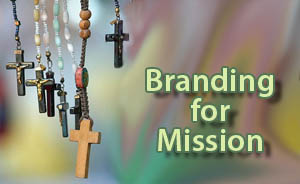 We’ve spent some time discussing the politics of church relations and how they related to a congregation’s branding or sense of mission.
We’ve spent some time discussing the politics of church relations and how they related to a congregation’s branding or sense of mission.
In the business world branding and advertising go hand in hand. What can the church learn from this?
Advertising is getting the word out. Evangelism is getting the Word out.
Congregations must learn to tell their story.
We have identified that the audience is not just the current members and the unchurched in your community. A primary audience for a congregation’s branding effort is its regional body, including the regional office, its officials and governing councils and every other congregation in your denominational territory.
Why is this important? Each congregation is vying for the same professional resources. Remember a primary task of your regional body is to fit clergy pegs into congregational holes. Making your ministry known to your regional body is an investment in making sure the peg that is placed in your congregation will move you forward.
Fact: a small church’s ability to serve—or even exist—depends on its relationship with its denomination. This runs counter to how congregations think. Church members will strategize for hours, weeks and years about how to reach and serve their communities. The regional body is out of sight and mind.
Here is a rarely discussed reality. All pastors are not created equal. Your regional body must find places for poor pastors along with the great. They will place poor pastors in the churches that are of the least perceived value to the regional body. You want them to know why your ministry, however small, matters.
Small churches must take extraordinary steps to attract the talent needed to serve members and fashion a ministry that will sustain a presence in the community. (That means meet the budget.)
This is great failing of the hierarchical church. Most communication between a congregation and the regional body is among clergy. It is usually prompted by sudden need or conflict.
Regional offices notice the big things. They will notice:
- If your church burns down.
- If the treasurer embezzled a few thousand.
- If the congregation receives a major bequest.
- If the pastor is unhappy or in trouble.
- If a congregation stops sending benevolence (They won’t ask why! They will assume you are in dire straits! You must tell them!).
Regional bodies won’t take special note:
- When your congregation rallies to help a family with a seriously ill child.
- When your congregation supports a local charity fundraiser.
- Votes to supplement a staff salary package during a trying time.
- Teaches art and music to neighborhood children in an after-school program.
- Does any number of small initiatives to improve the faith lives of their members and reach out to the community.
Ironic! These actions are the heart and soul of ministry.
Congregations must regularly communicate these things no matter how mundane or obvious they seem. An added challenge—so much of a congregation’s work must be done anonymously. All the more reason to be intentional about what you can share—and it’s all part of branding.
A Few Action Steps
Make sure your regional leaders and any staff assigned to your region are on your newsletter mailing list. Send it in a large envelope with a cover letter pointing to your most outstanding news. Even if you’ve gone internet with your parish communications, print a few and mail them to your regional office. Don’t rely on them looking up your newsletter or website!
Send invitations to events to church leaders and the pastors and church councils of neighboring congregations. Even if they don’t come, they will be impressed. They might start talking about you in a positive way! (It’s called buzz marketing).
Schedule events worthy of attention beyond your membership. In the past, hierarchies initiated events worthy of broad interest. That doesn’t exclude congregations from taking the lead. Consider a topic. Choose a format: guest speaker, workshop, panel discussion or webinars. Such initiatives will brand your church as thought leaders regardless of size. Does this seem impossible for your small family church? Think about a presentation on the value of the family church!
Use your website to address issues that concern your congregation and others. This is another common shortcoming of congregations. Their web sites are little more than online brochures. Think beyond your property line! You will be building your image as a mission-minded congregation.
Use photos. When you hold a successful events, follow up with a card with a photo to every participant and your regional office. Personal greeting cards are great communication tools that are underused.
Insist that lay leaders be included in dialog with the regional office. It is absolutely critical that regional leaders come to know lay leaders. This will take some doing. Regional offices like to expedite all meetings. They will attempt to deal with the leaders that make their goals easy to achieve. Make sure your pastor understands that you expect your elected lay leaders to be included in the dialog.
Encountering Resistance
You may encounter resistance among your professional leadership, but it should be easy to point out that such efforts boost their image with the regional office along with the congregation’s.
The biggest obstacle is that the time and energy spent on this activity are not part of the usual pastoral routine.
But then, the “usual” doesn’t seem to be working very well these days!








